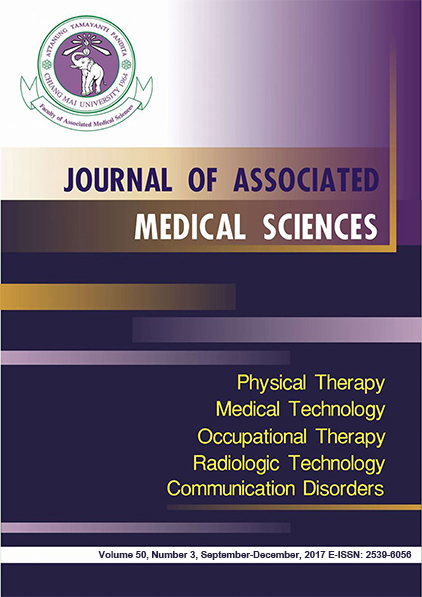The correlation between body mass index and postural control in individuals with obesity class I and normal BMI in 20-35 year-old
Main Article Content
Abstract
Background: Obesity, as classified by body mass index (BMI), is a term used to describe a person who is very overweight, with a lot of body fat, which negatively affects to health especially balance and postural control in individuals with obesity.
Objectives: To evaluate the correlation between BMI and postural control in normal individuals and individuals with obesity class I.
Materials and methods: Thirty-two young healthy adults aged between 20 to 35 years old from Mae FahLuang University; Chiang Rai were recruited. Participants were divided by BMI into 2 groups; normal BMI group (BMI=18.5-22.99 kg/m2, N=16) and obesity class I group (BMI=25.0-29.99 kg/m2, N=16). The participants were assessed balance using Romberg test, Sharpened Romberg test, Dominant leg standing test, and Ipsilateral remembered matching task. Data were analyzed by Pearson correlation which p value was established at <0.05 to determine the correlation between these variables.
Results: In obesity class I group, BMI had a positive correlation with Ipsilateral remembered matching task of left leg (r=0.624, p=0.010), and Ipsilateral remembered matching task of non-dominant leg (r=0.610, p=0.012) in moderate level.
Conclusion: These results indicated that BMI is not correlated with postural control in obesity class I groups.
Article Details
Personal views expressed by the contributors in their articles are not necessarily those of the Journal of Associated Medical Sciences, Faculty of Associated Medical Sciences, Chiang Mai University.
References
2. Ponghan P, Suntayakorn C, Prachanban P, Wannapira W. Effects of Health Promotion Program on Metabolic Syndrome Preventive Behaviors among Health Volunteers. J Nurs Health Sci 2015; 5(1): 54-64 (in Thai).
3. Greve J, Alonso A, Bordini AC, Camanho GL. Correlation between body mass index and postural balance. Clinics (Sao Paulo) 2007; 62(6): 717-20. doi: 10.1590/S1807-59322007000600010.
4. Dutil M, Handrigan GA, Corbeil P, Cantin V, Simoneau M, Teasdale N, et al. The impact of obesity on balance control in community-dwelling older women. Age (Dordr) 2013; 35(3): 883-90.doi: 10.1007/s11357-012-9386-x.
5. Ledin T, Odkvist LM. Effects of increased inertial load in dynamic and randomized perturbed posturography. Acta Otolaryngol 1993; 113(3): 249-52.
6. McGraw B, McClenaghan BA, Williams HG, Dickerson J, Ward DS. Gait and postural stability in obese and nonobese prepubertal boys. Arch Phys Med Rehabil 2000; 81(4): 484-9. doi: https://doi.org/10.1053/mr.2000.3782
7. Maffiuletti NA, Agosti F, Proietti M, Riva D, Resnik M, Lafortuna CL, et al. Postural instability of extremely obese individuals improves after a body weight reduction program entailing specific balance training. J Endocrinol Invest 2005; 28(1): 2-7.
8. Srisai M. Neuroanatomy. Bangkok: Year Book Pub., 2003 (in Thai).
9. Gandevia SC, Refshauge KM, Collins DF. Proprioception: peripheral inputs and perceptual interactions. Adv Exp Med Biol 2002; 508: 61-8.
10. Ahmad CS, Stein BE, Jeshuran W, Nercessian OA, Henry JH. Anterior cruciate ligament function after tibial eminence fracture in skeletally mature patients. Am J Sports Med 2001; 29(3): 339-45. doi: https://doi.org/10.1177/03635465010290031501
11. Melzer I, Oddsson LI. Altered characteristics of balance control in obese older adults. Obes Res Clin Pract 2015; 10(2): 151-8. doi: http://dx.doi.org/10.1016/j.orcp.2015.05.016
12. Johnson BG, Wright AD, Beazley MF, Harvey TC, Hillenbrand P, Imray CH. The Sharpened Romberg test for assessing ataxia in mild acute mountain sickness. Wilderness Environ Med 2005; 16(2): 62-6.
13. Promsri A. The influence of age on the constant error of joint position sense of the lower extremities. J Assoc Med Sci 2015; 48(1): 59-66 (in Thai).
14. Riemann BL, Guskiewicz KM, Shields EW. Relationship between clinical and forceplate measures of postural stability. J Sport Rehabil 1999; 8(2): 71-82.
15. King AC, Challis JH, Bartok C, Costigan FA, Newell KM. Obesity, mechanical and strength relationships to postural control in adolescence. Gait Posture 2012; 35(2): 261-5. doi: 10.1016/j.gaitpost.2011.09.017.
16. Hergenroeder AL, Wert DM, Hile ES, Studenski SA, Brach JS. Association of body mass index Withself-report and performance-basedmeasures of balance and mobility. Physther 2011; 91(8): 1223-34. doi: 10.2522/ptj.20100214.
17. Blaszczyk JW, Cieslinska-Swider J, Plewa M, Zahorska-Markiewicz B, Markiewicz A. Effects of excessive body weight on postural control. J Biomech 2009; 42(9): 1295-300. doi: 10.1016/j.jbiomech.2009.03.006.
18. Briggs RC, Gossman MR, Birch R, Drews JE, Shaddeau SA. Balance performance among noninstitutionalized elderly women. Physther 2012; 69(9): 748-56.
19. Simoneau M, Teasdale N. Balance control impairment in obese individuals is caused by larger balance motor commands variability. Gait Posture 2015; 41(1): 203-8. doi: 10.1016/j.gaitpost.2014.10.008.
20. Dhanani SD, Parmar LD. Normative values of tandem and unipedal stance in school children. Int J Curr Res Rev 2014; 6(24): 24-30.


